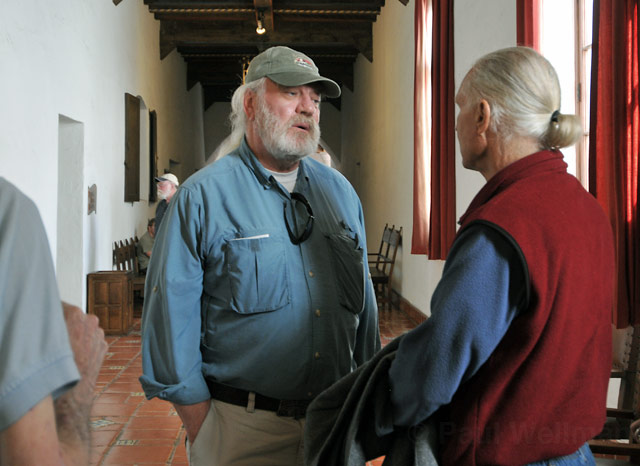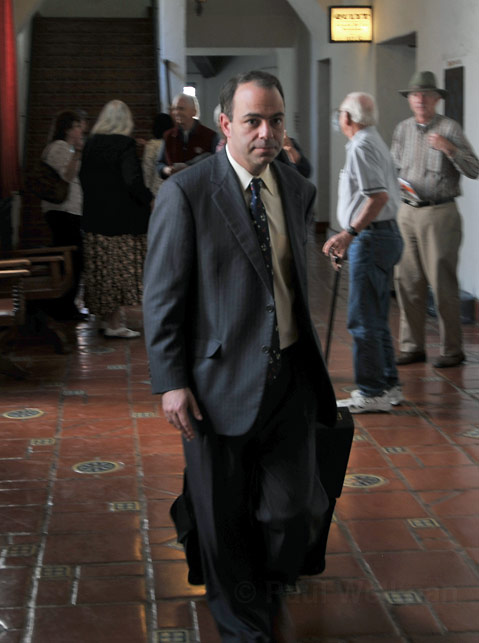Goleta’s Mobile Home Battle Goes to Court
Rancho Homeowners Fight Park Owner and City of Goleta over Condo Conversion
The battle over converting a Goleta mobile home park into condos hit the Santa Barbara County Courthouse on Friday, as the attorney for the homeowners of Rancho Mobile Home Estates argued against the lawyers for the park’s owner, Daniel Guggenheim, and the City of Goleta, which approved the conversion last year. The park’s 150 homeowners — including the more than two dozen in attendance on Friday and hundreds more mobile home park residents throughout Goleta — stand to lose a significant amount of equity in their homes if the conversion goes through, says Ken Tatro, president of the Monarch Country Mobile Home Owners Association, so they’re trying to defeat in the courts what they could not stop at Goleta City Hall.

This case is distinct from the other lawsuit involving Guggenheim and the Rancho homeowners, in which Guggenheim has sued the City of Goleta over its rent control ordinance. That case is currently being decided by the Ninth Circuit Court of Appeals, which heard arguments in June and is expected to issue a decision toward the end of the year.
At issue before Judge Denise de Bellefeuille in her jam-packed courtroom was whether the conversion had been done properly as dictated by state law. The homeowners’ attorney James Ballantine argued that the Goleta City Council approval was illegal, because neither a survey nor a tenant impact report had been completed in a timely manner or been duly considered by the council. But both Guggenheim’s attorney Tom Casparian and Goleta City Attorney Tim Giles argued that the survey and report had, in fact, been completed and both were considered, thereby validating the condo conversion approval.
Specifically, the parties are disagreeing over a 2005 survey that had been conducted in some manner. In court on Friday, Ballantine argued that it was not “homeowner approved” as mandated by state law; that it was outdated and irrelevant to the 2009 approval, being four years and a separate project prior; and that the city council did not “consider” the survey in any substantial way. “The bottom line is that what the city approved was not backed up by a survey,” said Ballantine, adding, “At no point did the decision makers do what the law required them to do.” The same can be said for the tenant impact report, which Ballantine says was never presented to the tenants.

In his statements to the judge, Casparian attempted to quickly deflate Ballantine’s case by charging that the homeowners’ arguments have endured “many iterations” and been “hyperbolic.” He argued that state law does not mandate the survey or tenant impact report be timely — he produced documents to show that such a report had been issued years ago — and that the decision makers needn’t dwell on the survey or report during their deliberations in order to qualify that some sort of appropriate consideration had occurred. He cited an email about the old survey as evidence that the homeowners had approved it and said that the 2005 project, upon which the existing survey was based, is essentially the same as what was approved in 2009 save for some “technical revisions.”
Giles, in essence, claimed that the city’s hands had already been tied into approving the matter, as a court order by Judge Thomas Anderle relegated the decision to being on a ministerial level without much wiggle room for discretion. As to the timeliness argument, Giles argued, “All of these factors are beyond the statute.” He also wondered aloud why the case was even being argued at this level because official approval must come from the Coastal Commission, as the property is in the coastal zone. “I’m not sure why we’re here asking the court to weigh in when a final decision hasn’t been made,” he said.
In responding to the arguments of Casparian and Giles, Ballantine again brought up the timeliness notion, explaining that there was likely a shifting pool of residents between 2005 and 2009 and asking why the state legislature would require a survey to be done but then not intend for that survey to be a major part of the decision-making process. He also referred back to the record, showing that both the park owner and the City of Goleta in 2007 agreed the survey and tenant impact report had not been completed. How then, inferred Ballantine, could the city and park owner now be saying that the old survey and report mattered while admitting on record that they didn’t count before?
That’s the question being pondered now by Judge de Bellefeuille, who did not give much indication of her inclinations on Friday.


